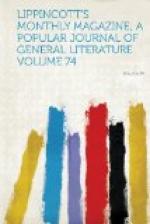[Illustration: Dom Pedro, emperor of Brazil.]
In art domestic exhibits utterly lose their preponderance. Our artists content themselves with a small fraction of the wall- and floor-space in Memorial Hall and its northern annex. In extent of both “hanging” and standing ground they but equal England and France, each occupying something over twenty thousand square feet. Italy in the aesthetic combat selects the chisel as her weapon, and takes the floor with a superb array of marble eloquence, some three hundred pieces of statuary being contributed by her sculptors. She might in addition set up a colorable claim to the works executed on her soil or under the teaching of her schools by artists of other nativities, and thus make, for example, a sweeping raid into American territory. But she generously leaves to that division the spoils swept from her coasts by the U.S. ship Franklin, together with the works bearing her imprint in other sections, satisfied with the wealth undoubtedly her own, itself but a faint adumbration of the vast hoard she retains at home. Italy does not view the occasion from a fine-art standpoint alone. Of her nine hundred and twenty-six exhibitors, only one-sixth are in this department.
[Illustration: Japanese carpenters.]
Nor, on the art side of our own country, must we overlook the Historical division, the perfecting of which has been a labor of love with Mr. Etting. He allots space among the old Thirteen, and reserves a place at the feast of reunion to the mother of that rebellious sisterhood.
Forty acres of “floor-space” sub Jove remained to be awarded to foreign and domestic claimants. Gardening is one of the fine arts. Certainly nothing in Memorial Hall can excel its productions in richness, variety and harmony of color and form. Flower, leaf and tree are the models of the palette and the crayon. Their marvelous improvement in variety and splendor is one of the most striking triumphs of human ingenuity. A few hundred species have been expanded into many thousand forms, each finer than the parent. It is a new flora created by civilization, undreamed of by the savage, and voluminous in proportion to the mental advancement of the races among whom it has sprung up. Progress writes its record in flowers, and scrawls the autographs of the nations all over Lansdowne hill. No need of gilded show-cases to set off the German and Germantown roses, the thirty thousand hyacinths in another compartment, or the plot of seven hundred and fifty kinds of trees and shrubs planted by a single American contributor. The Moorish Kiosque, however, comes in well. The material is genuine Morocco, the building having been brought over in pieces from the realm of the Saracens, of “gul in its bloom” and of “Larry O’Rourke”—as Rogers punned down the poem of his Irish friend.




